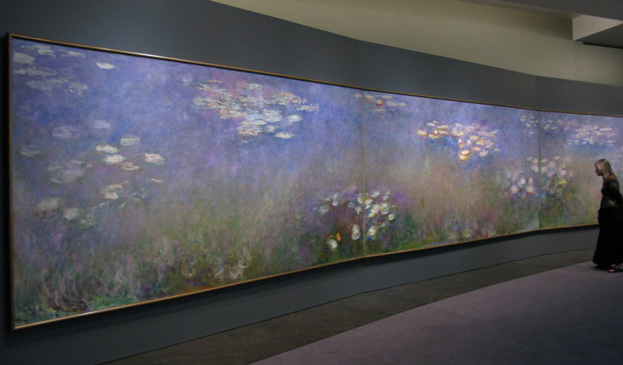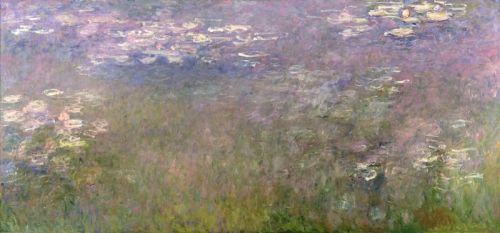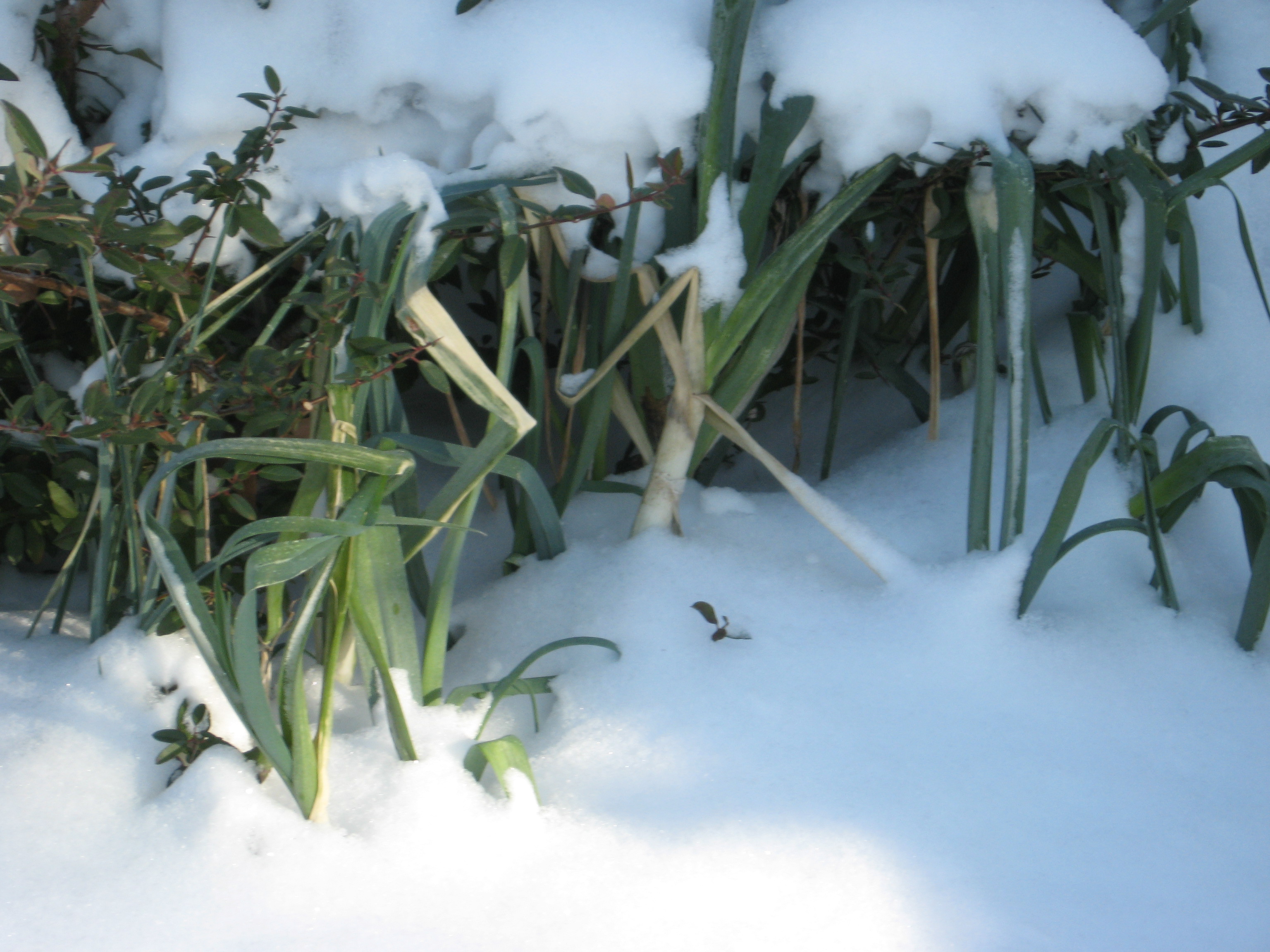A couple of weeks ago, I returned to my roots.
As a kid, I grew up in an art-poor community. Mom didn’t believe in letting us watch much TV. And the local libraries were typical of the bible belt–big on religious stories, low on art books.
Mom had a few books, though, and if I was very, very good, I was allowed to sit under the window, in the good light, with a huge art book in my lap and carefully page through it. Many were the rainy days spent that way, in the VM’s childhood.
Many were the days, and many were the paintings I grew to love.
Now, we didn’t have much money. Mom’s art books were mostly Time Life books bought at garage sales. The World of Leonardo, The World of Cezanne, The World of Vermeer. They brought a lot of joy to my life–their slightly off-color, overly orange and green reproductions with their odd smell and the grainy texture and the slight smeariness. Today I know they were done cheaply, but at the time, they amazed me and moved me.
We had many late night conversations, my mom and I, when it was too hot to sleep and the world was quiet. We would sit in the kitchen and eat icy-cold oranges from the frig and enjoy them sweet segment by sweet segment while she told me about these strange painters. Cezanne, who loved trees. Van Gogh, whose mind was beautiful but a bit broken. Degas, who drew the most amazing horses and the most tired dancers. Marie Cassat, who first taught me that women could paint, too. Monet, who painted haystacks at every time of day and night, just to catch the light.
I understood that people made art. I’d watched my mom make contour drawings. I’d seen her use watercolors and I’d played with them myself. (I’d even experimented with the smelly oils from the paint by numbers that my grandmother gave me with great disapproval from my mom, who told me I was not at all required to paint within the lines, or even depict the picture as stated. Naturally, I changed the cheerful kittens to glorious horses and then ran out of gray paint. But I digress.)
I understood, as I say, that people made art. That they put pigment on paper or paint on canvas and so created a piece of art. But what I experienced as art were…small things.
Most of them were reproductions the size of an adult’s hand. Many were reproductions the size of my own childish hand.
I’d been to the local museum before, to see the knights in their armor when my brother was interested in swords and Camelot, and we’d gone on school trips to see those rooms full of fancy furniture or old relics dug up from the ground. And sometimes we’d even gone to rooms where the paintings were. But the paintings I saw were, well, mostly boring pictures of dead guys in black suits and funny hats, looking like they had a bad stomach ache and never laughed.
So when mom took me to see Monet’s Waterlilies, all three, together, it was like a whole new world.
These were paintings as big as trucks.
Bigger! Bigger than trucks. And it was one of the coolest things I’d ever seen.
Those paintings took up so much space it was like the whole world had gone blue and green and full of light and weedy flowers and if you got close you could see all these brushstrokes.
The brushstrokes were a revelation.
Up until then, I’d never known that you could make a painting that actually showed brushstrokes. I mean, in a reproduction that’s 2″ by 3″, even the boldest Van Gogh looks like it leaped out of a head fully formed. But these waterlilies now, they were….different.
They were so big, so grand, so loud, in a watery garden kind of way.
And they didn’t even have people in them! No lines, either! Just colors. But they were so beautiful. Like walking under the sea should be.
Those paintings moved me and touched me and somehow imprinted on me the idea that it was OK to let the world see that a real hand was involved in making the image, that it was OK to paint as big as you needed, and that art could be a little messy, a little undomesticated.
I’d been drawing even before then, but it had always been hard for me to create any kind of link between the Big Real Art in the books and the carefully crafted pencil and crayon work I made on endless sheets of lined notebook paper.
Years passed, as years do. I learned more about art. I visited the museum many times after that, and mom provided me with more supplies so that I graduated from crayons to markers and conte and watercolors. I learned how to check art books out from the adult section of the library, and so learned about more modern artists. When I had the chance to take a class in high school on art, I leaped at it. To my initial joy, one of my teachers was an expert on the Impressionists. She told us that there were three qualities that they had: they were interested in light, they never used lines, and they did not use the color black, ever.
She was furious when I helpfully (I thought) brought in a library book where I’d carefully marked all the paintings that had black.
I ended up barely passing that class, but my love of the art never diminished. Mom and I got to see the touring Courtauld Collection when it came, but nothing quite surpassed that first rush of awe when I came across those huge three paintings all together, big as the world.
My life grew and changed some more, but weaving through it all was this love of art. I went back to the museum many times, seeing the single waterlily painting on its lonesome, seeing other art works, falling in love with different pieces, and going home to try my own things, time and again.
In the thirty years since those three paintings were together, I picked up a love of Caravaggio and a fondness for black and white pen work. Something else changed.
I came to understand something more about these paintings, from an utterly different direction. I’d heard, in that god-awful class so many years ago, that Impressionists were obsessed with light. And they were.
But for two decades now, I’ve been not just an artist, but a gardener. I know the shift that comes at the turn of mid-August, where the high hot sun goes to the right a bit, shading more and burning less, even though the temperatures are high. I know the dawn cold light that creeps from the East. I know the warm, sleepy light of dusk as it moseys back down beneath the crown of the world.
Winter’s brightness, pale lemon and cold.
So different from the mellow, long light of Summer.
And I know the feel of dirt under my nails, the endless sweat on the back of my neck, bent to sow seeds or trim, to weed or loosen soil. The way the toads hang in the shade under clay pots, the chirrup of crickets and the long endless slide up and down drone of cicadas.
It’s a world I can slip into, free from thought, and just be. Taking in endless variations of the color green, satisfied completely by the visual beauty of a mixed patch of double-dug earth planted with chards and zinnias and silver beet and kale and cottage marigolds.
I have not only basked in its beauty, I have run out into it, bare feet slipping on wet leaves, yelling at the top of my voice and shaking my fist, a five foot four whilwind in silly pajamas, chasing off the rabbits from my tomatoes.
I’ve fought slugs with little tins of beer, I’ve stood ankle deep in water where none should be, I’ve planted and ripped out and walked and walked and walked, through all the seasons. I know my plants in ice, in snow, in the first green blush of returning spring, as well as the glory of summer.
So when I went back to the Water Lilies, I was a different person.
The museum had gone to considerable effort to make it a good experience. It’s not easy to host a forty-five foot long, fifteen feet tall triptych worth millions, but they did a lovely job. The wing where it was housed is the ultra-modern add-on, very sleek, all white flat paint and long, sweeping graduated floors. Frameless art, big windows, quiet thermostat controlled air.
They’d given the Water Lilies their own space and in front of them, they’d grouped benches for seating, upholstered in gray and almost rock-shaped. The lighting was soft, but focused. I took my mom and we went on a quiet weekday. It was possible to sit and look and just enjoy, as if you were at a real pond. You can see what the setup looks like here.
With all this lead up, perhaps you’re hoping for explosions! Revelations! Amazement!
But no. Or at least, not of the exciting kind.
I sat down on a pebble-shaped bench and looked at the huge paintings in front me. So blue and so lush. It really did feel a bit like stepping into another world.
As I gazed at them, I found my breathing slowing, and I stretched out my bad leg and let out a long, comfortable sigh. My eye traveled up the painting, to the left, up to the corner, to the right, and back down again, never feeling the need to focus in on only one spot, never feeling the impulse to stop looking, just moving my gaze naturally from place to place.
A bit like I would look on my own garden back home.
Formally, the water lilies are a little off. The perspective is almost as if from a bridge looking down, but the eye moves up to what should be a sky, but never is. But I couldn’t care less. For me, it feels only as if I’m inside the garden. Feeling it around me, the way my own clayey soil feels sticky and scratchy under my bare feet.
The context that existed in real time–the stark white and gray paint, the smell of controlled air and mingled perfumes, the soft squeak of guard shoes on marble–slipped away. Instead, I was in a garden, caught in a patch of sleepy shade with the certain knowledge, brought by the tickling breeze and my inner senses, that outside the shade would be hot sun. The smell of wet, brackish greenery, rotting and decomposing in the summer. The soft drone of the ever-singing cicadas, nature’s orchestra that serenades late summers and leaves its empty carapaces as bodily echo.
I sat for a long time, content.
*
There are other contexts for these paintings.
I know that the Water Lilies I saw exhibited were only one of the many water lilies Monet painted. The Museum of Modern Art in New York has another triptych which is even permanently displayed together. There are beautiful books about the paintings, the techniques, the influences, the painter himself.
The gardens at Giverny are open to visitors, and a good friend of mine visited there just two weeks ago. She shared the pictures she took (one and two) and I was able to drink in the bright flowers and even note, with a gardener’s eye, the invasives that were going to be giving them trouble in another few years.
I can use an online web tool to view the painting in great detail. I can use my academic research tools to find out detailed critiques and formal investigations into meaning, technique, history. I can buy as many books with reproductions of his paintings as I’d like or get myself poster-sized reproductions to hang on my own wall.
In a few years, the parts of triptych I saw will return to their homes, and I’ll be able to visit our panel, as I might visit an old friend.
Monet painted them in his studio together and kept working on them for years until his death in 1926. I don’t know that he’d have particularly imagined them in that huge, modern white building. But I think he’d have been pleased that they were together and that they brought about not just critical insights, but also that indescribable summer outside feeling, sleepy and peaceful, soft sky and wet marshy greens.
Nor I do think he’d mind that when I want to recapture that feeling, I might wander outside into my own garden to feel the mud squelch under my toes, and sit under a heavy old oak, and watch the breeze play games with the flowers.




